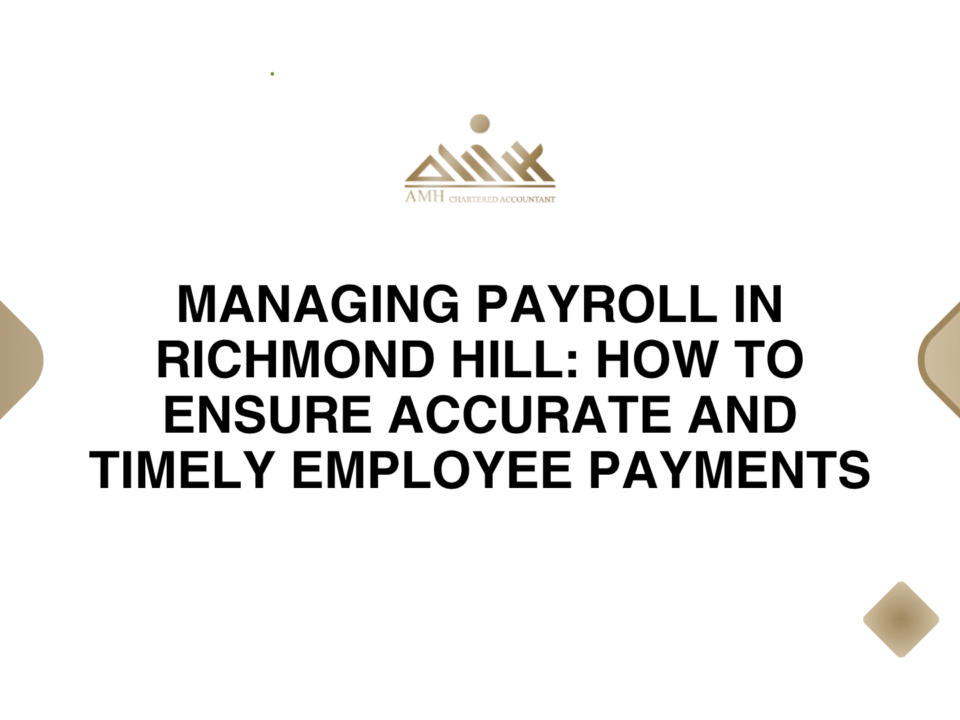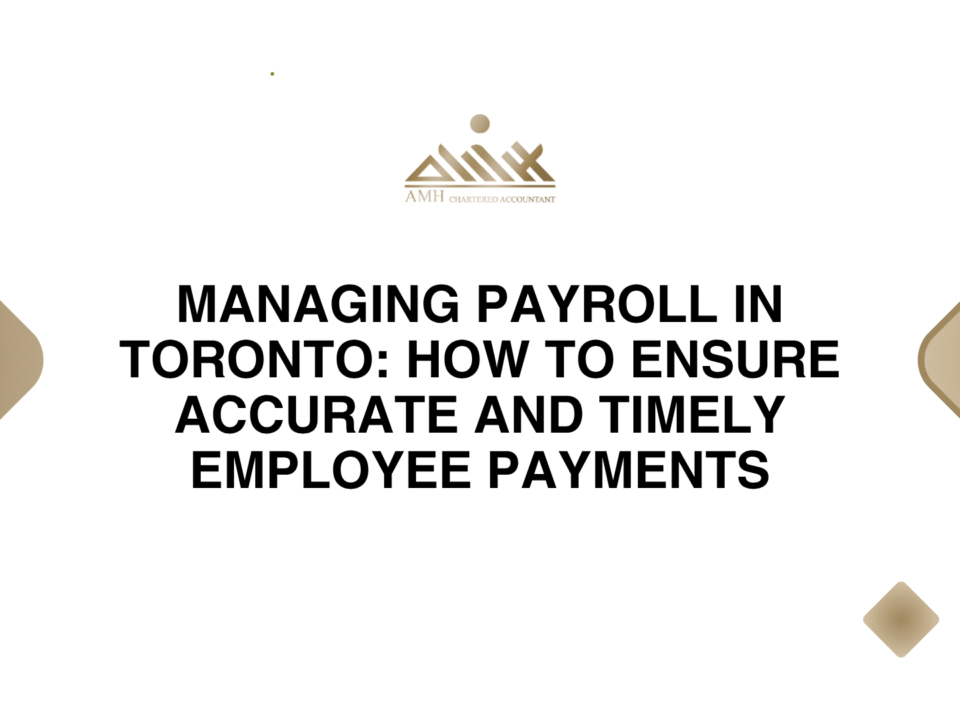
Optimizing Cash Flow: Practical Tips for Growing Companies
June 15, 2025
9 Internal Audit Tips to Reduce Financial Risk in Your Corporation
June 25, 2025How to Accurately Track Project Costs in Service-Based Companies
Tracking project costs is essential to ensure profitability and efficiency for service-based businesses. Here’s how to track your costs accurately with insights from AMH Chartered Professional Accountant.
Introduction: The Importance of Tracking Project Costs
In service-based businesses, whether you’re providing consulting, marketing services, or custom IT solutions, understanding the financials of each project is crucial. For these companies, it’s not just about making sales but about controlling costs and ensuring profitability. Accurately tracking project costs allows service providers to estimate future projects better, adjust budgets, and maintain healthier profit margins.
AMH Chartered Professional Accountant understands the complexities service businesses face when tracking costs and we’re here to help guide you through the best practices, offering tools and strategies that can help streamline this process. Whether you’re in Toronto, Milton, Oakville, Hamilton, or Waterloo, we help businesses like yours optimize financial management while maintaining competitive pricing.
Why Project Cost Tracking Matters for Service-Based Companies
Service-based companies, unlike product-based businesses, often deal with intangible deliverables. Whether you’re working on a website development project, managing a marketing campaign, or providing legal services, the costs involved can sometimes be hard to pin down. Proper tracking of project costs helps you:
Ensure Profitability: If you don’t track costs, you might end up undercharging or spending more than anticipated.
Manage Cash Flow: A detailed breakdown of project costs helps with managing cash inflows and outflows, ensuring you have the liquidity to meet your obligations.
Improve Estimation Accuracy: The more accurately you track project costs, the better you can estimate future projects and avoid overcommitting or underpricing.
Understanding Direct and Indirect Project Costs
To accurately track costs, it’s important to understand the difference between direct and indirect project costs:
Direct Costs: These are expenses that can be directly attributed to a specific project. For example, labor costs (employees or contractors working directly on the project) and materials needed for the project.
Indirect Costs: These are expenses that are necessary for business operations but cannot be directly linked to a specific project. Examples include overhead costs like utilities, office supplies, or general management salaries.
Tip: Accurate tracking involves allocating these costs correctly to each project.
Setting Up a Project Costing System for Service-Based Businesses
A good costing system for service-based companies is one that breaks down every element of a project. Here are the key steps in setting up such a system:
Identify Key Project Components: Start by identifying the major components of each project—labor, materials, overhead, and any other relevant costs.
Use a Project Management System: Implement a system to assign costs to specific projects. Tools like Trello, Asana, or Microsoft Project are useful for breaking down tasks and associating costs with specific deliverables.
Create Cost Categories: Break down the costs into subcategories such as:
Labor (direct and indirect)
Materials and supplies
Equipment and software used
Subcontractor fees
Overhead
Role of Time Tracking in Project Cost Management
For service-based companies, labor often forms the bulk of project costs. Effective time tracking is crucial to ensure accurate billing and cost management.
Time Tracking Systems: Software such as Harvest, Toggl, or Clockify enables service companies to track hours worked on specific projects or tasks.
Linking Time to Projects: Ensuring that employees or contractors log their time directly against the project ensures that labor costs are accurately accounted for in the project budget.
Tip: Ensure all team members are trained on the importance of logging time accurately to prevent discrepancies and overrun costs.
Time Tracking and Labor Costs
Labor is one of the most significant expenses for service-based companies. It is essential to calculate labor costs accurately to assess whether a project is on budget.
How to Calculate Labor Costs for Projects
Hourly Rates: If employees or contractors are billed hourly, you can easily calculate labor costs by multiplying the hours worked by the hourly rate.
Salaries: For salaried employees, break down their salary into an hourly rate by dividing their annual salary by the number of working hours in a year. Then, allocate their hours to the relevant project.
Project-Specific Labor Costs: For contractors or temporary workers, track their hours or fixed project fees to ensure accurate accounting of the cost to each project.
Material Costs and Non-Labor Expenses
While service-based companies may not have physical products, many still incur material costs (e.g., software licenses, specialized tools, office supplies) and other non-labor expenses.
Allocating Overhead Costs to Projects
Overhead costs need to be allocated to each project based on the hours worked or resources used. You can calculate this by dividing total overhead costs by total project hours, and then applying this rate to each project’s time.
Tip: Use percentage-based allocation methods to keep it simple. For example, if a project takes up 10% of total company resources, allocate 10% of overhead costs to that project.
How to Estimate and Budget Project Costs Effectively
Accurate cost estimation is key to ensuring that your projects remain profitable. Follow these steps to improve your cost estimates:
Track Historical Data: Review past projects to gather data on labor hours, material costs, and overhead. This historical data helps set benchmarks for new projects.
Identify Risks: Every project comes with inherent risks. Include contingency funds in your estimates to account for unforeseen issues.
Consult with Experts: Have project managers, senior staff, or accountants review cost estimates to ensure accuracy before finalizing them.
Best Practices for Managing Project Budgets
To ensure you stay on track with your project costs, keep the following best practices in mind:
Break Down Large Projects: Divide big projects into smaller tasks or milestones. This will allow for more accurate tracking and control.
Create Buffer Budgets: Allocate some extra funds for unforeseen costs but ensure these don’t become slush funds.
Review Regularly: Don’t wait until the end of a project to review costs. Regular check-ins, at least monthly, ensure that you can make adjustments as needed.
Handling Unforeseen Costs and Changes in Scope
As projects progress, scope changes and unforeseen expenses are inevitable. To handle these efficiently:
Scope Control: Set clear project scopes from the outset and ensure any changes are documented, agreed upon, and accounted for.
Contingency Plans: Have contingency plans and extra funding in place to address unexpected costs or changes in project requirements.
Tip: Be proactive about communicating changes with clients to prevent surprises.
Monitoring and Analyzing Project Costs in Real-Time
Real-time tracking helps catch discrepancies early, rather than waiting until project completion.
Real-Time Software: Use project management or accounting software like QuickBooks Online or Xero to monitor costs and project statuses in real time.
Cost Tracking Reports: Regularly generate reports to compare actual spending with your budget. Look for patterns and areas that need improvement.
Creating Accurate Project Cost Reports
At the end of a project, create a detailed report outlining:
Total Project Costs: Labor, materials, overhead, and unexpected costs.
Budget vs. Actual: Compare the actual costs with the projected budget.
Profitability: Calculate the difference between your projected revenue and actual costs to assess project profitability.
Reviewing Project Costs Post-Completion
Once a project is completed, conduct a post-mortem analysis to evaluate how well costs were managed:
Lessons Learned: Identify what went well and where improvements can be made in future projects.
Client Feedback: Engage clients in conversations about cost accuracy and scope to improve future estimates and client relationships.
How AMH Chartered Professional Accountant Can Help
At AMH Chartered Professional Accountant, we specialize in helping service-based businesses track project costs effectively. From cost tracking systems to budget forecasting, our team provides expert advice and customized solutions to streamline your project cost management.
We also help with:
Real-Time Financial Dashboards
Cost Forecasting and Budget Creation
Expense Tracking Software Implementation
Comprehensive Financial Reports
The Role of Accountants in Project Cost Control
Accountants play a critical role in project cost control by providing:
Oversight on Project Budgets
Tax Planning for Service-Based Projects
Tracking and Reporting on project finances to ensure profitability
FAQs
What software is best for tracking project costs in service businesses?
Tools like QuickBooks Online, Xero, Zoho Books, and Harvest are ideal for tracking both labor and material costs in real time.
How do I allocate indirect costs to specific projects?
Use a percentage-based allocation method based on the resources each project uses. For example, if a project consumes 10% of company resources, allocate 10% of overhead costs to it.
Should I track costs daily or weekly?
Daily tracking helps catch discrepancies early, but weekly reviews provide more time for analysis and adjustments.
How do I handle changes in project scope?
Document any changes immediately and adjust the budget and timeline accordingly. It’s crucial to communicate these changes with clients to prevent misunderstandings.
Can AMH help me set up a project cost system?
Yes! We provide tailored cost tracking systems, ensuring you can track, manage, and report on project costs effectively.




